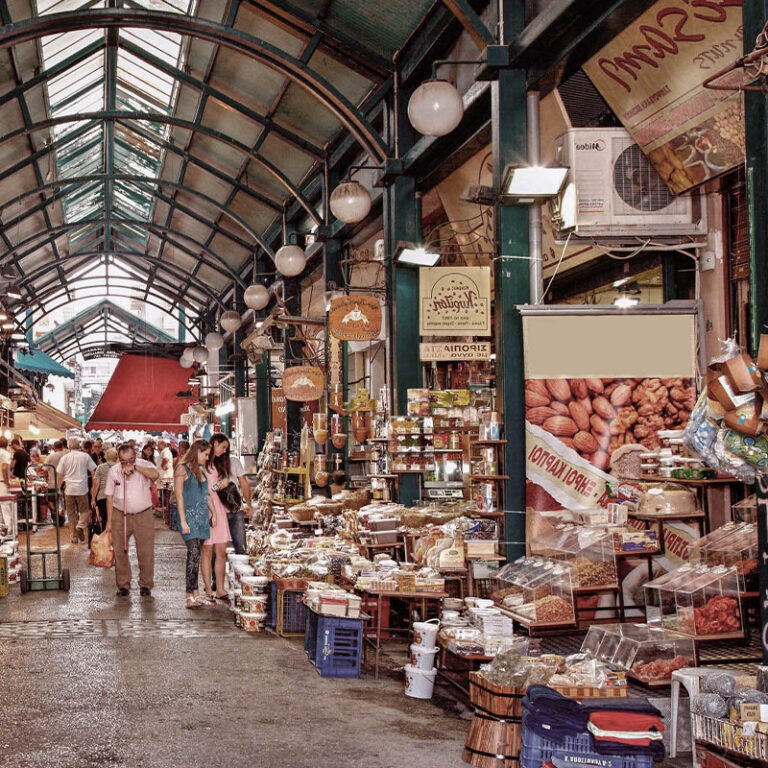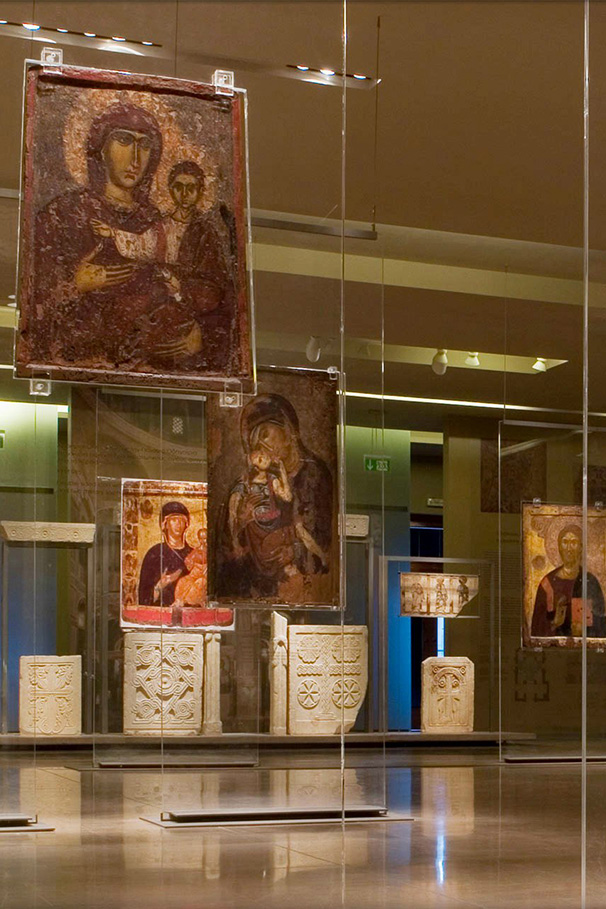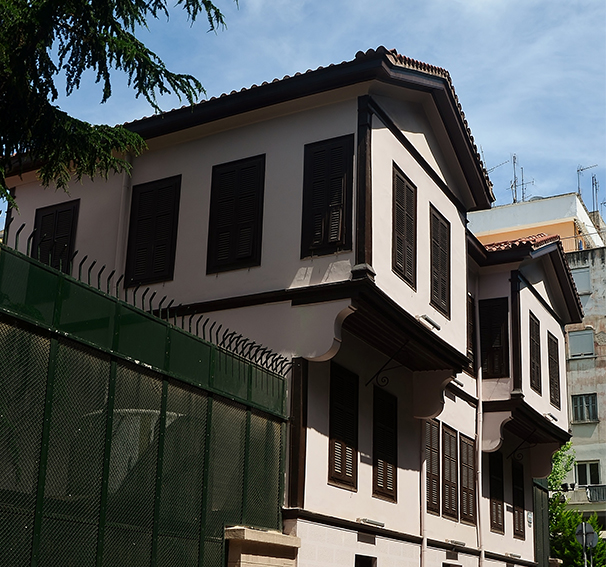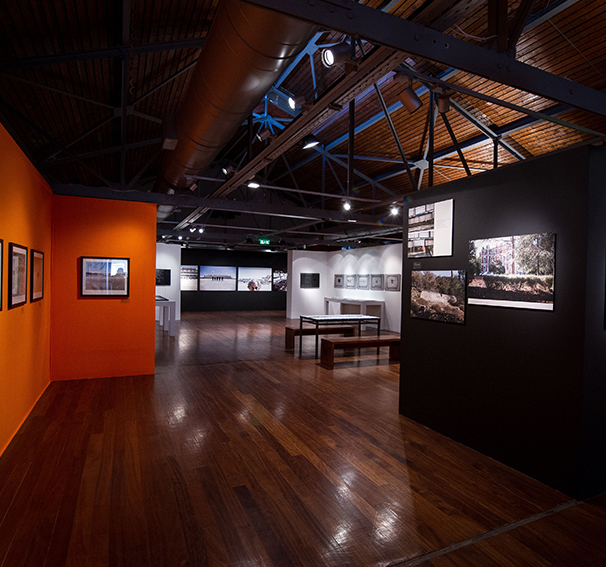Museums
White Tower (1.6km)
It is the symbol building of Thessaloniki and one of the most famous buildings in Greece. It is located in a prominent position at the beginning of Nea Paralia and has a height of 33.90m and a diameter of 22.70m.
Its original name was "Tower of the Lion", according to a Turkish inscription of 1535-1536 and which was located at the entrance of the outer enclosure. From the 17th century it was called the 'Fortress of Kalamaria' and the 'Tower of the Janissaries'.
The White Tower was built by the Ottomans at the end of the 15th century when Sultan Murat II occupied Thessaloniki. Its architect was probably the famous Mimar Sinan. The Tower was for centuries part of the walls of the old city of Thessaloniki that separated the Jewish quarter of the city from the Muslim and Jewish cemeteries. The Ottomans used the White Tower in a successive order. Initially, as a fortress, then as a garrison and finally as a prison.
After the dissolution of the Janissary order in 1826, it acquired the name 'Tower of Blood' due to the massacres by the Janissaries. The name was preserved even after 1826 due to its function as a prison for the dead of Baripoinites and a place of torture, which were often executed by the Janissaries filling the walls with blood. According to one version, its modern name seems to have been taken when a Jewish convict, Nathan Guidili, whitewashed it in exchange for his freedom, in 1891. Another historical source states that the current name of the building was given between the years 1883 and 1884 at the request of Sultan Abdul Hamid II or at the initiative of the governor of the city of Ghalip.
In 1985, the restoration of the monument was completed and it was turned into a museum and exhibition center.
The view from the balcony, where the blue and white waves wave, is panoramic and the visitor can gaze at Thermaikos gulf, Mount Olympus, Ano Poli or Eastern Thessaloniki.
Archaeological Museum of Thessaloniki (1.9km)
The Archaeological Museum is located in the YMCA square, next to the International Exhibition of Thessaloniki. It was founded after the liberation of the city in 1912 and the current building was inaugurated in 1962 when the city celebrated 50 years of its liberation. The architect was Patroklos Karatinos. The exhibits, which it hosts, come from the excavations that have been carried out in the city of Thessaloniki and in the wider region of Macedonia.
The Museum houses finds from the excavation research in the city's plots and in archaeological sites, and in particular from the activity of the Antiquities Tax Administration, which covers the prefectures of Thessaloniki, Kilkis, Pieria, Halkidiki.
For a long time it hosted the findings of the excavations of Manolis Andronikos in the Royal Tombs of Vergina. The finds from the cemetery of Sindos are housed in the inner rooms. Objects from the Neolithic, Classical, Hellenistic and Roman eras are exhibited in the outer rooms, while the prehistoric collection is exhibited on the lower floor, presenting the visitor with a timeless picture of the cultural evolution not only in Thessaloniki but also more widely in the entire Central Macedonia region.
Museum of Byzantine Culture of Thessaloniki (2.2km)
The Museum of Byzantine Culture is located on Stratos Avenue directly across from Areos Field and behind the new city hall on an area of 3,430 sq.m. It started operating in 1994 and in 2005 was awarded the Council's 'Museum Award' of Europe while the building is considered one of the best works of public architecture in Greece.
The 11 rooms of the museum host exhibitions that present the architecture and decoration of churches, in the early Christian years, aspects of economic life, housing equipment and elements of clothing and nutrition, burial of the dead in early Christian cemeteries of the city, a tribute to the culture of the middle Byzantine period (8th-12th century AD), tribute to Byzantine emperors, engraving collections, presentation of the Byzantine heritage after the Conquest by the Ottomans and finally presentation of the course of the archaeological objects from excavation to their transfer to the museum.
The visitor has the opportunity to understand the cultural and socio-political facts that influenced people's lives during the Byzantine and post-Byzantine era.
Jewish Museum of Thessaloniki (0.1km)
The Jewish presence in Thessaloniki is centuries old and inextricably linked to the history of the city. The mission of the Jewish Museum of Thessaloniki is to highlight the rich history of the community to the general public, to preserve the memory of the victims of the Holocaust as well as to research the over two thousand year presence of the Jews in the city. It was founded in 2001 and is housed in one of the few surviving buildings from the great fire of 1917.
It has collections of tombstones from the destroyed Israeli Cemetery, building members from synagogues demolished by the German occupation authorities, religious objects, old and rare books in the Hebrew language, family heirlooms, ketubot, public and private documents related to World War II , private letters, clothing, textiles, tablecloths, books as well as bank deposit books (up to 1940).
The museum also maintains the only existing collection of pre-war family and school photographs, formed from ongoing donations, and has the most important collection of business records from Thessaloniki. Finally, a special exhibition space refers to the Holocaust, as it affected the Jewish Community of Thessaloniki as a whole.
Ethnographic and Folklore Museum of Macedonia - Thrace
The Ethnographic and Folklore Museum of Macedonia-Thrace is located on Vasilissis Olgas Street in a beautiful, well-preserved historical building of the 20th century, known as "Modiano Villa", the residence of the banker Yiako Modiano and his family. His work is to discover and study the traditional culture of recent years in several regions of Northern Greece.
The collections consist of objects from the pre-industrial era, mainly from the regions of Macedonia and Thrace. They represent the way people lived during the last centuries until the middle of the 20th century in both the countryside and the city. In terms of their quantity and variety, this is one of the richest collections of its kind in the whole of Greece.
The objects housed in the Museum come from purchases and donations and include local clothing, jewelry, textiles and embroidery, craftsman's tools, farm implements, household utensils, furniture, musical instruments, toys, church equipment, as well as early forms of machinery (cameras , sewing machines).
Ataturk Museum of Thessaloniki (1.7km)
The Atatürk Museum of Thessaloniki is housed in the house where Mustafa Kemal Atatürk, founder and first president of the Turkish Republic, was born in 1881 and spent his youth. It is located behind the Turkish Consulate at 75 Apostolou Pavlou Street.
Most of the furnishings are original. Some missing furniture had to be replaced with others taken from the Mausoleum of Kemal and from Topkapi in Constantinople.
The visitor can see personal belongings of the Turkish leader, period photos, photographs and various writings.
The fact that thousands of Turks visit the home of the founder of modern Turkey reflects the radiance that Kemal Atatürk's personality still retains today.
Thessaloniki Museum of Photography (0.5km)
The Museum of Photography of Thessaloniki is the only museum in the country dedicated to the art of photography, it is supervised by the Ministry of Culture & Sports and organizes an international photography festival every two years. It opened its doors in 1998 and in 2001 it was housed in Warehouse A of the port of Thessaloniki.
Its mission is focused on planning and presenting a series of exhibitions, creating archives and collections from photographers' material and publishing books and catalogues.
At the same time, he takes care of the organization of educational programs and has undertaken important initiatives for the promotion of Greek photography at an international level.
Sights
Holy church of Agios Dimitrios
The holy church of Agios Demetrius is located in Thessaloniki and is dedicated to Agios Demetrius, the patron saint of the city. It is located on the street of the same name and is a five-aisled basilica of the "Hellenistic type", but with many special and rare characteristics compared to other temples of the same period in Greece. It has a transversal nave and rich painting and marble decoration with ornate capitals. In the basement of the church is the place of martyrdom of the Saint. Among its mosaics, the one that depicts the Saint himself with two small children stands out, and another that depicts the Saint between the bishop and the prefect, who renovated the church in the 7th century.
In the great fire, which destroyed 2/3 of the city in August 1917, it burned almost completely and was restored in 1948 preserving many of its architectural elements. Thanks to the architect Aristotelis Zachos, who had kept notes, drawings and photographs, the church was restored "from its foundations" to be given again to the worship of the faithful on October 26, 1949, the day of the saint's feast day.
Shortly thereafter, in 1978, the relics of the Saint were returned from the Abbey of Saint Lawrence in Campo, Italy and placed in a silver urn where they are kept to this day.
In 1988 the temple was declared a World Heritage Site by UNESCO.
Since 1988, the crypt of the temple has functioned as an exhibition space (museum exhibition), where a collection of sculptures, capitals, chests and vases from the various phases of the history of the temple of Agios Dimitrios are exhibited.
Upper Town - City Walls (1.1km)
The area of Thessaloniki known as the Upper Town is built in the northwest and starts from the area above Agios Dimitriou Street, Olympiados Street and reaches the Acropolis and Eptapyrgio. It is the only part of Thessaloniki that remained intact from the great fire of 1917. The special architectural style will take you back to the Byzantine era.
Due to its location, it was also the main fortress of the city with defensive structures, which were created during the Byzantine and Ottoman Periods. A large part of the Byzantine walls have been preserved and are now a jewel of the Acropolis of Thessaloniki.
The Upper Town can be visited on foot or by bus. Stroll through the cobbled streets surrounded by small beautiful Ottoman architecture houses and enjoy the amazing panoramic view of the city and the sea, especially during the sunset hours. Have lunch in the small taverns with traditional cuisine, some of them are more than a century old! You can also find souvenirs in small tourist shops in the area, near Portara and Trigonio Tower.
Arch of Galerius (Kamara)
The arch of Galerius also known as "Kamara" is one of the most recognizable and distinguished Roman monuments of Thessaloniki. It is perhaps the most popular destination for both locals and visitors to the city.
It is a monument of a triumphal nature that brings together many interesting elements of Roman monumental architecture while it was dedicated to the victorious campaign of Emperor Galerius against the Sassanids of Persia and the capture of their capital Ctesiphon in 298 AD. As the arch was part of the wider architectural complex that included the Palace and the impressive cylindrical building of the Rotunda in a single entity, we can perceive the rich and intense Roman past of the city.
Kamara is the most common meeting point for most of Thessalonica and the city's impressively large student community. It is extremely accessible (Egnatia Street) while many other attractions and areas that deserve your attention are within walking distance. There are many cafes around the monument and the people who frequent them are mainly students.
Rotunda (1.5km)
The Rotunda is one of the most important Roman monuments in Greece. It is a domed round building of the 4th century, in the eastern part of the historical center of Thessaloniki, similar to the Pantheon in Rome, which was intended as a temple of Zeus or the Kaveri and a mausoleum of the emperor Galerius.
Due to its non-use, it was converted during Byzantium into a Christian temple of the Incorporeal Powers and after the Liberation of Thessaloniki, in 1912, it was dedicated to Saint George.
It is part of the palace complex of Emperor Galerius and was built around 304 AD. Since 1988, it has been a UNESCO World Heritage Site.
Nea Paralia - Seaside Promenade of Thessaloniki (2.0km)
For city dwellers, walking (and in recent years running) along it is a favorite habit.
In the 3.5 km that the walker will cross, he can enjoy the sun, the sea and the sky of Thessaloniki. It has a demarcated space for cyclists along the beach front from the Concert Hall to the port.
Visitors walking along it will have the opportunity to admire the impressive umbrellas of Zongolopoulos, the statue of Alexander the Great, the statue of K.Karamanlis, the Royal Theater, the green theme parks, while the most romantic can enjoy a ride with the buggies or to relax on the boats that function as floating bars, cafes, restaurants throughout the day and night.
Aristotelous Square (0.5km)
Aristotelous Square is one of the central squares of Thessaloniki. It was designed by the French architect Ernest Hebrard in 1917 immediately after the great fire of 1917, which incinerated the center of Thessaloniki. It starts from the semi-circular buildings to the north of Mitropoleos Street, which crosses it at this point, and continues to Nikis Avenue at the sea.
The square is a popular spot for tourists and locals, with many cafes and restaurants and is a venue for political gatherings and various artistic events. The imposing corner buildings house the 'Olympion' cinema which is the seat of the Thessaloniki International Film Festival and the 'Elektra' hotel.
Just above the square, the remains of the Roman Agora were discovered, which is a place of attraction for many tourists. On the left and right of Aristotelous Square are the traditional and well-known commercial markets of Thessaloniki: Modiano, Kapani and Athonos.
Gastronomy

The multitude of people who have lived within the walls of the city over the centuries, with their eating habits that have mixed and assimilated over time, the combination of oriental flavors with European cuisines, the love and zest for life that characterizes the inhabitants of the co-capital are the reasons for creating culinary feasts in the ouzories, kitchens and restaurants of the city.
Thessaloniki is the gastronomic metropolis of Greece, a crossroads of tastes, a marriage of tradition and innovation. The remnants of Byzantine customs, the traditions of the Greek refugees from Constantinople, Pontus and Asia Minor mixed with Jewish and Balkan flavors and together with French tasting created the special culinary profile of the city.
Enjoy your morning coffee with “bougatsa”, salty or sweet, and a sesame bun. Taste stuffed buns and Panorama triangles with warm salepi.
Plenty of ouzo and local restaurants are scattered throughout the city ready to welcome and give the visitor hedonistic moments of tasting and gastronomy: seafood, fresh fish, cooked with fresh herbs, dishes with pine nuts, raisins and various spices and of course for dessert traditional, oriental syrupy sweets or “spoon sweets”.
Entertainment

Markets

The large streets of Thessaloniki that were laid out many decades ago house the largest market in the Balkans. Tsimiski, Mitropoleos, Proxenou Koromila and Egnatia streets, as well as large shopping centers such as Mediterranean Cosmos, Notos Galleries, One Salonika and “Macedonia” host on their shelves the fashion paradise for clothing, footwear and beauty.
But it is also worth a walk to the traditional markets of Thessaloniki: Modiano, Kapani and Athonos, which are in themselves an attraction of the city. Food, spices, seafood, meat, fresh fish, vegetables and fruits, clothing and footwear and many other small treasures inside the covered markets record the daily pulse of the city and the life of its inhabitants.





